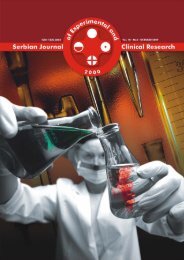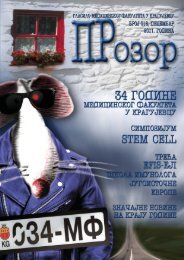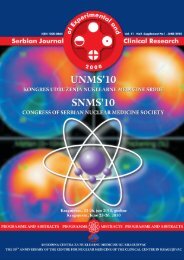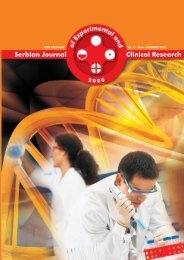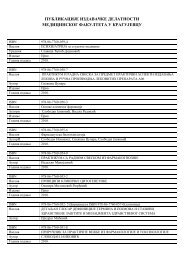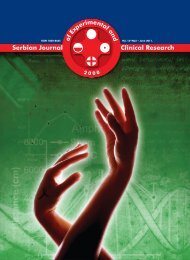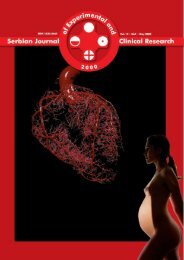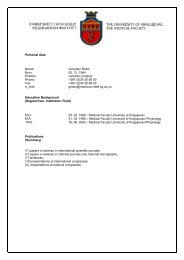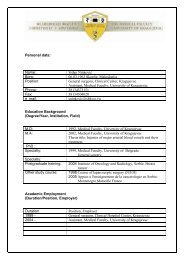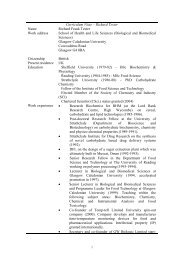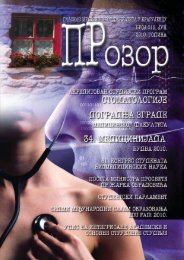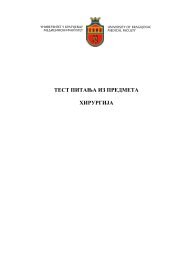neurotoxicity and mechanisms of induced hyperexcitability
neurotoxicity and mechanisms of induced hyperexcitability
neurotoxicity and mechanisms of induced hyperexcitability
You also want an ePaper? Increase the reach of your titles
YUMPU automatically turns print PDFs into web optimized ePapers that Google loves.
ORIGINAL ARTICLE ORIGINALNI NAUČNI RAD ORIGINAL ARTICLE ORIGINALNI NAUČNI RADSTRUCTURAL INVESTIGATION OF DEXTROMETHORPHANUSING MASS SPECTROMETRY AND THERMALANALYSES COMBINEDWITH MOCALCULATIONSM.A. Zayed *1 , M.A. Fahmey 2 , M.F. Hawash 2 , S.A.M. Abdallah 31Chemistry Department, Faculty <strong>of</strong> Science, Cairo University, 12316 Giza, Egypt.2Nuclear Physics Dept., N.R.C., Atomic Energy Authority 13759, Cairo, Egypt.3University <strong>of</strong> Workers, 10 Aswan, A.R. EgyptReceived / Primljen: 10. 03. 2011. Accepted / Prihvaćen: 07. 04. 2011.ABSTRACT(C 18H 25NO, mole mass = 271) was investigated usingthermal analyses (TA) measurements (TG/DTG <strong>and</strong> DSC)compared with EI mass spectral (MS) electron impact fragmentationat 70 eV <strong>of</strong> electron energy. Semi-empirical MOcalculations using the PM-3 procedure were performed withdextromethorphan (DMP) as a neutral molecule <strong>and</strong> the correspondingpositively charged ion. These included moleculargeometry (bond length), bond order, bond strain, charge distributionon different atoms, heat <strong>of</strong> formation, <strong>and</strong> ionisationenergy. The mass spectral fragmentation pathways <strong>and</strong> thermalanalyses decomposition were proposed <strong>and</strong> comparedwith each other to select the most suitable scheme. In electronionisation (EI) mass spectral fragmentation, the initial rup-ture is due to C 3H 7N (bridge) loss followed by C 9H 11O. In TA,the primary loss is due to loss <strong>of</strong> C 3H 7N Bridge + HBr (afterH 2O loss <strong>of</strong> crystallisation). TA revealed a high response <strong>of</strong>the drug to the temperature variation with very fast rate. Itdecomposed in several sequential steps in temperature rangefrom 100ºC to 600ºC. The initial thermal decomposition wassimilar to that obtained using MS. So, it is possible to selectthe proper pathway using both techniques. This comparisonwas successfully confirmed by MO calculation. The structuralreactivityeffect on metabolism <strong>and</strong> the biological effect comparedwith codeine are discussed.Keywords: Dextromethorphan structure, Mass Spectrometry,Thermal analyses, MO calculationINTRODUCTIONDextromethorphan (DMP, methoxy-methyl morphinan)is an antitussive agent used in many nonprescriptioncough <strong>and</strong> cold medications [1]. DM has an IUPACname (+)-3-methoxy-17-methyl-(9α, 13α, 14α)- morphinan(C 18H 25NO, m/z=271) <strong>and</strong> is a synthetic product thatis chemically related to codeine [2]. The drug is a safe, oralantitussive that is widely available [3 – 6]. The structural formula<strong>and</strong> numbering system <strong>of</strong> the drug is given in Fig. 1.A number <strong>of</strong> methods have been reported to measureDM in biological fluids, including high-performance liquidchromatography (HPLC) [7, 8], gas chromatography (GC)[9, 10] <strong>and</strong> gas chromatography–mass spectrometry (GC–MS) [11-14, 1]. The latter technique is highly sensitive [5].Rapid advances in biological sciences have led to anincreased dem<strong>and</strong> for chemical <strong>and</strong> structural informationfrom biological systems. Mass spectrometry plays apivotal role in the structural characterisation <strong>of</strong> biologicalmolecules [15]. The technique is important because it providesa substantial amount <strong>of</strong> structural information usinga small amount <strong>of</strong> sample. Moreover, the techniques <strong>of</strong>fercomparative advantages in speed <strong>and</strong> productivity forpharmaceutical analysis [16]. In contrast, thermal analysisdelivers extremely sensitive measurements <strong>of</strong> heat change,which can be applied on a broad scale with pharmaceuticaldevelopment. These methods provide unique informationrelating to thermodynamic data <strong>of</strong> the system studied[17]. The increasing use <strong>of</strong> the combined techniques in TAcould provide more specific information <strong>and</strong> thus facilitiesa more rapid interpretation <strong>of</strong> the curves obtained [17].In the electron ionisation (EI) mass spectra, the fragmentationconsists <strong>of</strong> competitive <strong>and</strong> consecutive unimolecularfragmentation [18]. The fragmentation <strong>of</strong> the ionisedmolecule depends mainly on their internal energy [19]. Thethermo-gravimetric TG/DTG analysis provides quantitativeinformation on weight losses due to decomposition <strong>and</strong>/orevaporation <strong>of</strong> low molecular weight fragments as a function<strong>of</strong> time <strong>and</strong> temperature. In conjunction with mass spectrometricanalysis [20-22], the nature <strong>of</strong> the released fragmentsUDK 615.233.074 / Ser J Exp Clin Res 2011; 12 (1): 21-28Correspondence to: mazayed429@yahoo.com, Tel: 00202-22728437, 002-010577665.21



